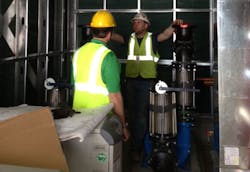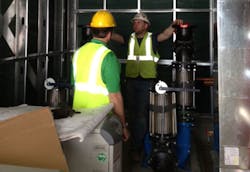Hyatt Place Chicago-South/University Medical Center saves lots of green in labor, material
CHICAGO — When Ryan Kerrigan, vice president, Sherman Mechanical Inc., in Cary, Illinois, was tasked with designing and installing the heat pump system for the new Hyatt Place Chicago-South/University Medical Center, he was presented with a different solution to the black piping that he was accustomed to using in projects of this kind.
Aquatherm Blue Pipe was offered as an alternative and with Kerrigan and his team never having used Aquatherm’s heat-fused, polypropylene systems before, he wanted to learn more.
Skip Newton, with PVF Solutions, the local Aquatherm representative, gave the team at Sherman Mechanical a presentation to show how the piping works.
“I really liked the fact the piping has thermal properties and again how light it was,” said Kerrigan. “One pipefitter can lift and carry a 20-foot piece of piping that is 8 inches in diameter, up on his shoulder.”
Training, certification
Newton, along with Columbia Pipe, an independent company that has been providing products, service and solutions for a wide range of industries since 1935, helped get three pipefitters — Anthony Mocarski, Doug Currier and Jerry Sutcliffe — trained and certified to heat-fuse the Aquatherm piping for the project.
Heat fusion is essential to the success of PP-R piping systems. The method joins plastic pipe and fittings by heating them to a molten state and then rapidly pressed them together to form a homogeneous, or monolithic, bond.
Mansion Hotel uses displaced heat to warm swimming pool
ClimateMaster celebrates Oklahoma Habitat for Humanity homes built with geothermal
Two-inch and below connections are made using socket fusion, which involves cutting the pipe, marking it for insertion depth, heating the pipe and fitting for a specified time on the heating iron, then manually pushing them together to cool. Once cool, the pipe and fitting become a single piece with no potential for leaks.
With pipe diameters of 4-in. and larger, butt fusion is used. This method uses a fusion machine to properly join the pipe and fitting using heat and pressure. Sherman Mechanical rented two fusion machines — one that fuses 3-in. pipe and smaller, and the other that fuses 4-in, pipe and larger, from Columbia Pipe. The pipefitters were trained on that equipment as well.
Training for socket fusion took approximately 2.5 hours and training for butt fusion took six to eight hours. The certification the pipefitters received lasts two years.
The project began in March 2012, and the Sherman Mechanical team installed approximately 2,500 feet of Aquatherm Blue Pipe in sizes ranging from 6-in pipe to 1-in pipe.
The piping was used for the condenser water in the building and connected the ClimateMaster TCH and TRM ¾-ton to 5-ton heat pump units, the Camus DMNH-801 800,000 MBH input boiler system, the Baltimore Aircoil PT2-0709A 375-gpm factory fabricated cooling towers and was also used for the Dectron Dry-O-Tron DS- 060 5,500 cfm pool dehumidification unit that was tied into the heat pumps.
Time, cost savings
The material and labor savings on this project was significant. The mechanical room where all the piping was installed was located on the 6th floor of the seven-story, 85,000-sq.ft. building.
According to Newton, pipefitters were able to walk the pipe up to the mechanical room, thus saving a lot of time and cost — there was no need to rent a crane.
As on any project, you can’t expect everything to run according to plan. Two days before the hotel was supposed to open, Kerrigan noticed that the engineer had submitted incorrect drawings for the piping to the heat exchanger. This caused the pipefitter to install the piping backwards because he was following the drawings.
“We had to send a crew of two pipefitters in to re-pipe the whole system in just two days and they finished in time for the hotel to open as scheduled,” Kerrigan said.
“The labor savings for this project was dramatic,” Kerrigan said. “We saved between 25% to 45% in the labor hours. We had 1,000 hours of piping on the job and saved at least 300 to 400 hours in labor. The pipefitters in Chicago make $82 per hour, so we were able to save about $25,000 in labor. We had significant cost savings and we were able to pass that savings along to the building owner.”
“This is the first time I’ve seen this type of piping,” said Harold Smith, Chief Engineer at the Hyatt. “The piping doesn’t require insulation and that saved the owner a lot of extra costs. That will help the hotel keep costs down for years to come.”
The Hyatt Place Chicago-South/University Medical Center opened as scheduled in August 2013. The 131-room hotel employs 35 staff members and can hold up to 700 guests.



